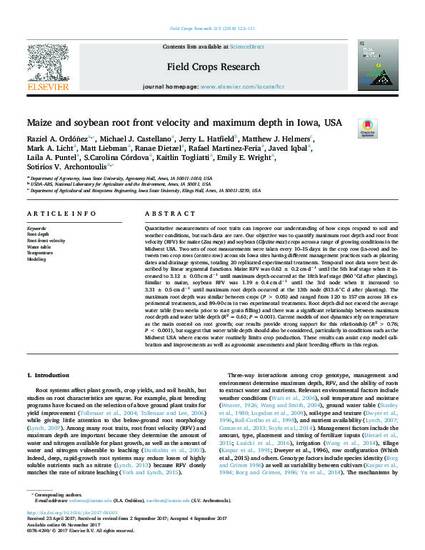
Quantitative measurements of root traits can improve our understanding of how crops respond to soil and weather conditions, but such data are rare. Our objective was to quantify maximum root depth and root front velocity (RFV) for maize (Zea mays) and soybean (Glycine max) crops across a range of growing conditions in the Midwest USA. Two sets of root measurements were taken every 10–15 days: in the crop row (in-row) and between two crop rows (center-row) across six Iowa sites having different management practices such as planting dates and drainage systems, totaling 20 replicated experimental treatments. Temporal root data were best described by linear segmental functions. Maize RFV was 0.62 ± 0.2 cm d−1 until the 5th leaf stage when it increased to 3.12 ± 0.03 cm d−1 until maximum depth occurred at the 18th leaf stage (860 °Cd after planting). Similar to maize, soybean RFV was 1.19 ± 0.4 cm d−1 until the 3rd node when it increased to 3.31 ± 0.5 cm d−1 until maximum root depth occurred at the 13th node (813.6 °C d after planting). The maximum root depth was similar between crops (P > 0.05) and ranged from 120 to 157 cm across 18 experimental treatments, and 89–90 cm in two experimental treatments. Root depth did not exceed the average water table (two weeks prior to start grain filling) and there was a significant relationship between maximum root depth and water table depth (R2 = 0.61; P = 0.001). Current models of root dynamics rely on temperature as the main control on root growth; our results provide strong support for this relationship (R2 > 0.76; P < 0.001), but suggest that water table depth should also be considered, particularly in conditions such as the Midwest USA where excess water routinely limits crop production. These results can assist crop model calibration and improvements as well as agronomic assessments and plant breeding efforts in this region.
Available at: http://works.bepress.com/castellano-michael/38/

This article is published as Ordóñez, Raziel A., Michael J. Castellano, Jerry L. Hatfield, Matthew J. Helmers, Mark A. Licht, Matt Liebman, Ranae Dietzel et al. "Maize and soybean root front velocity and maximum depth in Iowa, USA." Field Crops Research 215 (2018): 122-131. doi: 10.1016/j.fcr.2017.09.003.